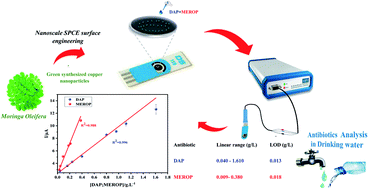Development of a sustainable nanosensor using green Cu nanoparticles for simultaneous determination of antibiotics in drinking water
Abstract
In this work, a novel, cost-effective, and eco-friendly electrochemical (EC) nanosensor was fabricated for the simultaneous detection of daptomycin (DAP) and meropenem (MEROP). EC methods have been developed for the determination of antibiotics. In this context, green synthesized copper nanoparticles (CuNPs) using Moringa oleifera plant extract were used as electrode modifiers. The incorporation of CuNPs was proposed to enhance the sensitivity and allow the simultaneous quantification of both antibiotics in water. Transmission electron microscopy (TEM), dynamic light scattering (DLS), attenuated total reflectance Fourier transform infrared (ATR-FTIR) spectroscopy, UV-visible spectroscopy, and field emission scanning electron microscopy with energy dispersive X-ray spectroscopy (FESEM-EDX) were employed to characterize CuNPs. Physical adsorption of 20.0 nm (±2.2 nm) spherical CuNPs on the surface of screen-printed carbon electrodes (SPCEs) induced a remarkable electrocatalytic effect. Indeed, the detection of both antibiotics exhibited a limit of detection (LOD) of 0.01 g L−1. The response to various interfering species was assessed. Finally, the quantification of DAP and MEROP in drinking water was demonstrated, confirming the potential of the developed sensor for environmental monitoring applications.



 Please wait while we load your content...
Please wait while we load your content...